Practice Management - Pain Physician
Practice Management - Pain Physician
Practice Management - Pain Physician
You also want an ePaper? Increase the reach of your titles
YUMPU automatically turns print PDFs into web optimized ePapers that Google loves.
Manchikanti • Documentation, Billing and coding 225<br />
The CPT 76005 is described as follows: fluoroscopy guidance<br />
and localization of needle or catheter tip for spine or<br />
paraspinous diagnostic or therapeutic injection procedures<br />
(epidural, transforaminal epidural, subarachnoid, paravertebral<br />
facet joint, paravertebral facet joint nerve or sacroiliac<br />
joint), including neurolytic agent destruction. Thus,<br />
if fluoroscopy is used this code may be used either with<br />
epidural or subarachnoid injection procedures with CPT<br />
codes 27096, 62270 to 62273, 62280 to 62282, 62310 to<br />
62319, 64470 to 64476, 64479 to 64484, 64600 to 64620,<br />
and 64622 to 64627. Hence, this code may not be used<br />
with percutaneous lysis of epidural adhesions (CPT<br />
62263), which includes radiologic localization and contrast<br />
administration; with cervical/thoracic discography<br />
(CPT 62291) or lumbar discography (CPT 62290). This<br />
code may not be used with 64630, 64640, 64680,<br />
epidurography code 72275, or 73542 - sacroiliac joint arthrography.<br />
The CPT 72275 - epidurography differs from fluoroscopy<br />
guidance and localization of needle or catheter tip CPT<br />
76005. Similarly, CPT 73542 - sacroiliac joint arthrography<br />
also differs from 76005, as it represents a formal contrast<br />
study that includes fluoroscopy as with epidurography.<br />
Thus, 76005 - fluoroscopy guidance, 72275 -<br />
epidurography, 73542 - sacroiliac joint arthrography,<br />
72285 – discography, cervical or thoracic, and 72295 –<br />
discography, lumbar, are not stand-alone codes and should<br />
always be used with appropriate procedural codes. In<br />
addition, either in case multiple injections or multiple attempts<br />
are made, fluoroscopy guidance code 76005 can<br />
be used only once.<br />
Frequency and Number of Injections or Interventions<br />
◆ In the diagnostic and stabilization phase, a<br />
patient may receive injections at intervals of no<br />
sooner than 1 week and preferably 2 weeks for<br />
most types of blocks except for blockade in<br />
cancer pain or when a continuous administration<br />
of sympathetic blocks is employed (8).<br />
◆ In the treatment phase (after the stabilization is<br />
completed), the frequency of interventional<br />
techniques should be 2 months or longer between<br />
each injection provided that at least >50% relief<br />
is obtained for 6 weeks (6). However, if the neural<br />
blockade is applied for different r egions,<br />
they can be performed at intervals of no sooner<br />
than 1 week and preferably 2 weeks for most type<br />
of blocks. The therapeutic frequency must remain<br />
2 months for each region. It is further<br />
suggested to treat all regions at the same time<br />
provided all procedures are performed safely (8).<br />
◆ In the stabilization phase, the number of<br />
injections should be limited to no more than four<br />
times per year in cases of all the blocks except<br />
sympathetic blocks, in which case six times<br />
should be reasonable.<br />
◆ In the maintenance phase, the interventional<br />
procedures should be repeated only as necessary<br />
judging by the medical necessity criteria and these<br />
should be limited to a maximum of six times for<br />
local anesthetic and steroid blocks and four times<br />
for interventions such as radiofrequency<br />
thermoneurolysis, and cryoneurolysis for a period<br />
of one year.<br />
◆ For percutaneous non-endoscopic adhesiolysis<br />
with a 3-day protocol, 2-3 interventions per year<br />
are recommended; with a 1-day protocol, a maximum<br />
of 6 times per year is recommended.<br />
◆ For endoscopic adhesiolysis, it is recommended<br />
that there be no more than 2-3 inter v e n t i o n a l<br />
procedures per year.<br />
◆ Under unusual circumstances with a recurrent<br />
injury, carcinoma, cervicogenic headache, or<br />
regional sympathetic dystrophy, blocks may be<br />
repeated at intervals of 6 weeks after stabilization<br />
in the treatment phase.<br />
Combination of Blocks/Interventions<br />
It may be essential to combine, in certain circumstances,<br />
more than one block (8). This may include an epidural for<br />
the cervical region and facet-joint blocks for the lumbar<br />
region; epidural and facet-joint blocks for the same region<br />
in case of identification of pain generators from both<br />
sources; a sympathetic block and facet-joint block if there<br />
are two different sources of pain or if two different regions<br />
are affected in combination with trigger-point injections<br />
(8). Consequently, blocks also may be combined<br />
with other interventional techniques.<br />
Number Per Setting<br />
It is recommended that a physician should consider a patient<br />
in totality and treat multiple regions of the patient in<br />
the same setting, as long as it is safe and feasible (8). Attempts<br />
to treat one particular organ at a different time are<br />
not an absolute necessity (8).<br />
<strong>Pain</strong> <strong>Physician</strong> Vol. 3, No. 2, 2000
















